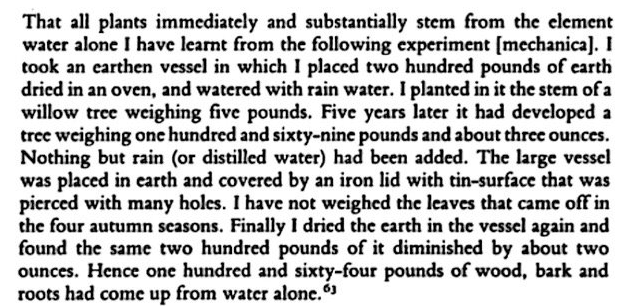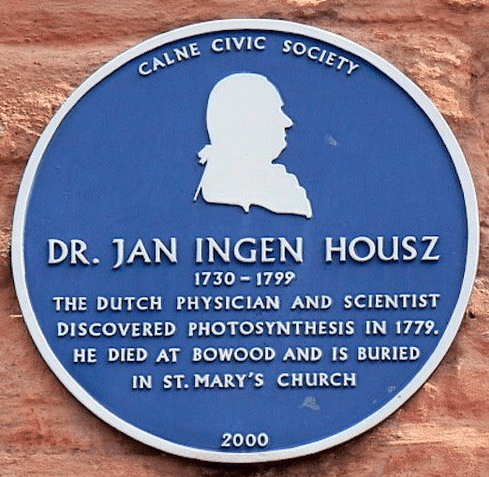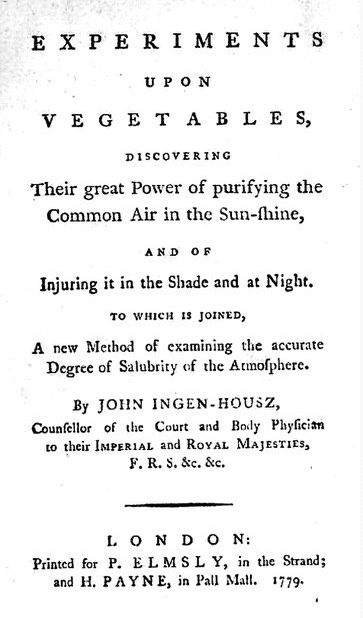JMS Pearce
Hull, England
 |
|
Fig 1. Portrait of J.B. van Helmont, 1683. Wellcome Collection. Public domain. |
The importance of plants in nutrition and in the environment of human and animal species needs no emphasis. How plants obtain their food and how they grow were unsolved mysteries until photosynthesis was discovered. It was generally believed that plants obtained food and energy directly from the soil alone. Three medical doctors uncovered important elements of the mechanisms of photosynthesis.
Jan van Helmont MD (1579–1644)
Van Helmont (Fig 1) was born into the Flemish gentry. He qualified in medicine aged twenty at Louvain, Belgium. In 1609 he married into a noble family and moved to the family estate at Mérode in Vilvoorde.
For the next seven years he dedicated himself to chemical research and to the relief of the poor. He tried to express vital phenomena in chemical terms. When a substance was consumed by fire, an ethereal essence would remain, for which he invented the word gas (from “chaos”). Though he knew that carbon dioxide and ferrous oxide were present in spa waters, he did not understand the mechanism of carbon fixation.
In his most famous experiment, he planted small willow saplings in an earthen pot and weighed the soil he placed in it. With sunlight and watering the willows grew rapidly over five years. He then extracted and weighed both plant and soil (Fig 2). Van Helmont deduced that that the growth of a plant must come from the element water within the plant’s tissues.
 |
| Fig 2. Van Helmont’s experiment. In Ortus Medicinæ, 1648. |
Obviously, he knew nothing of photosynthesis, but his use of the plant weight was an important first step.
Van Helmont also devised one of the early thermometers and clarified the laws governing the pendulum in music. He showed that acid is associated with digestion in the stomach and alkali in the duodenum. And he investigated the formation of kidney stones. He helped to combat an outbreak of plague in Antwerp in 1605.
Shortly before his death he charged his son, Francis Mercurius, with the publishing of his analects: Ortus Medicinæ (Origin of Medicine), 1648.
John Pringle MD FRCP FRS (1707–1782)
The influential physician, Sir John Pringle (1707–1782), during the Austrian War of Succession was physician-general to the British forces, stationed by chance near the Ingenhousz home. Pringle strongly supported Ingenhousz’s career (vide infra) and became a close family friend; he encouraged Ingenhousz to read medicine at the Catholic University of Louvain, where he received the MD degree summa cum laude in 1753. After further study in Leiden and Edinburgh, he returned to Breda as a general practitioner.1
In 1764 Pringle introduced Ingenhousz to the famous anatomists William and John Hunter, and Alexander Monro, tertius. And significantly, he knew and exchanged ideas with Joseph Priestley and Benjamin Franklin, who were lifelong friends.2
In 1774 Joseph Priestley (1733–1804) discovered oxygen, or de-phlogisticated air, and carbon dioxide, fixed air, when he noticed that air made “foul” by burning a candle in it could be re-vivified by plants that emitted oxygen.3 Similarly, Antoine Lavoisier showed that “good air” was rich in oxygen, while in “bad air” the oxygen had reacted to form carbon dioxide. Priestley’s Copernican notion that plants could purify air, exchanging oxygen and carbon dioxide, were reiterated by Pringle at the Royal Society in November 1773 when he stated:
“…no vegetable grows in vain, but that from the oak of the forest to the grass in the field, every individual plant is serviceable to mankind… [because it] cleanses and purifies our atmosphere.”
However, before Priestley, Scheele, and Lavoisier’s identification of oxygen c. 1774, the gas had been purified and used to sustain human life and exercise by the Dutch engineer Cornelis Jacobszoon Drebbel (1572–1633).3
 |
 |
| Fig 3. Left: Blue plaque in Calne. Photo by Brian Robert Marshall on geograph.org.uk. CC BY-SA 2.0. Right: Jan Ingenhausz. Halftone via Wikimedia. Public domain. |
|
Jan Ingenhousz MD FRS (1730–1799)
Ingenhousz (Fig 3) was the son of a leather merchant. From the age of 16, he studied and graduated MD at the University of Louvain. He was a remarkable doctor, physiologist, and chemist, yet few remember his name. He fought smallpox, refined microscopy, and discovered how plants grow.
Inspired by Priestley (“with a kind of ecstasy”), Ingenhousz noted aquatic plants when exposed to daylight emitted tiny bubbles of gas, but when placed in the dark the bubbles almost ceased. He concluded the gas emitted must have been caused by light. And, when he collected the bubbles, they would reignite a glowing splint—which meant the plant bubbles were oxygen.
In Experiments Upon Vegetables: … 1779 (Fig 4), Ingenhousz said:
“I observed that plants not only have a faculty to correct bad air in six or ten days, by growing in it, as the experiments of Dr. Priestley indicate, but that they perform this important office in a complete manner in a few hours. This wonderful operation is by no means owing to the vegetation of the plant, but to the influence of the light of the sun upon the plant. This office is not performed by the whole plant, but only by the leaves and the green stalks that support them.”4
 |
| Fig 4. Ingenhousz, Experiments upon Vegetables, 1779. Via Google Books. |
In the dark, plants emitted small volumes of gas, which would extinguish a flame, so he deduced this was carbon dioxide. By the summer of 1779, Ingenhousz had performed five hundred experiments.
Ingenhousz proved that all plants absorbed carbon dioxide and they emitted oxygen. This was a vital step on the way to understanding photosynthesis. Furthermore, he showed that plants, like animals, undergo cellular respiration.
He also studied electricity, chemistry, and heat conduction. In 1769 he was elected a Fellow of the Royal Society. In 1799 he died at Bowood House, near Calne in Wiltshire, and was buried in the nearby churchyard (blue plaque, Fig 3).
An unrelated area of Ingenhousz’s achievements was in 1767 when to combat a smallpox epidemic in Hertfordshire he successfully inoculated by variolation seven hundred village people, some thirty years before Jenner’s vaccination (1796). At the request of Empress Maria Theresa (1717–1780) to King George III, whose family he had variolated, Ingenhousz was dispatched to Vienna, where supported by Gerhard van Swieten, personal physician to ruler of the Habsburg dominions, Ingenhousz successfully inoculated Maria Theresa’s family against smallpox and was appointed her personal physician.
In 1775, he married Agatha Maria Jacquin in Vienna; they were childless. Ingenhousz’s bust is in the arcades of the Vienna University next to Van Swieten’s.
Later work on photosynthesis
Half a century later, Julius von Sachs FRS (1832–1897) was born in Breslau, and was said to be the father of plant physiology.5 The physiologist Jan Evangelista Purkinje MD, (remembered for Purkinje cells in the cerebellum) in 1851 engaged Sachs to work with him in Prague. Sachs studied botany and agriculture and later became professor of botany at Freiburg, then at Würzburg.
Sachs’ experiments were a crucial advance in the understanding of the mechanisms of photosynthesis. First, he showed that all green leaves contained starch. He did this by staining leaves with tincture of iodine that turned starch dark blue. Secondly, if the leaves were hidden from daylight, his test for starch was negative, showing that that sunlight was necessary for the synthesis of starch, which he realized was the source of the plants’ energy and growth. Thirdly, in 1817 Sachs discovered that chlorophyll was confined to special cells named chloroplasts. During photosynthesis, chlorophyll absorbs energy from blue- and red-light waves, and reflects green-light waves, making the plant appear green. In the same year the French chemists Pierre Pelletier and Jean Caventou had named the green pigment extracted from leaves chlorophyll.
 |
| Fig 5. Chlorophyll within chloroplasts. Photo by Kristian Peters (Fabelfroh) on Wikimedia. CC BY-SA 3.0. |
Sachs also observed heliotropism: plants’ movements towards a light source. In 1882 he published his findings in Vorlesungen über Pflanzenphysiologie (Lectures on the Physiology of Plants). The University of Würzburg botanical garden is at Julius-von-Sachs-Platz 4.
Richard Willstätter was awarded the 1915 Nobel Prize for establishing the formulae of chlorophyll a and chlorophyll b. They were subsequently synthesized by Robert Woodward in 1960.
Our knowledge of photosynthesis was refined by Andrew Benson (1917–2015), a physician’s son, who worked in the Berkeley, California laboratory of Nobel Prize winner Melvyn Calvin FRS (1911–1997).6 Benson was a superb chemist, one of the first to use radioisotopes to study biochemical pathways.7 Using radioactive carbon-14 from a cyclotron and two-dimensional paper chromatography, his experiments showed that starch contained several different sugars vital in carbon assimilation in plants.8 Although Calvin was awarded the Nobel Prize “for his research on the carbon dioxide assimilation in plants,” the Oxford botanist Timothy Walker decried Calvin’s treatment of Andrew Benson, claiming that Calvin had got the credit for Benson’s work after firing him, and had failed to mention Benson’s role in his autobiography decades later.9
References
- Gest H. Bicentenary homage to Dr Jan Ingenhousz, MD (1730–1799), pioneer of photosynthesis research. Photosynthesis Research 2000; 63: 183–190.
- Ingen Housz JM, Beale N, Beale E. The life of Dr Jan Ingen Housz (1730–99), private counsellor and personal physician to Emperor Joseph II of Austria. J Med Biogr 2005;13 (1):15–21.
- Poole DC, White MJ, Whipp BJ. The discovery of oxygen. Hektoen Int Winter 2015.
- Ingenhousz J. Experiments upon Vegetables—Discovering Their Great Power of Purifying the Common Air in the Sunshine and of Injuring It in the Shade and at Night. London: P. Elmsly and H. Payne, 1779.
- Kutschera U. Basic versus applied research: Julius Sachs (1832-1897) and the experimental physiology of plants. Plant Signal Behav. 2015;10(9).
- Melvin Calvin 8 April 1911 – 8 January 1997. Biogr. Mems Fell. R. Soc. 54, 59–70 (2008).
- Buchanan, BB., Douce, R. & Lichtenthaler, H.K. Andrew A. Benson. Photosynth Res 92, 143–144 (2007).
- Calvin M, Benson AA. The Path of Carbon in Photosynthesis, Science 1948;107:476.
- Walker T. Botany: A Blooming History. BBC Four. BBC, 2011.
JMS PEARCE is a retired neurologist and author with a particular interest in the history of medicine and science.

Leave a Reply